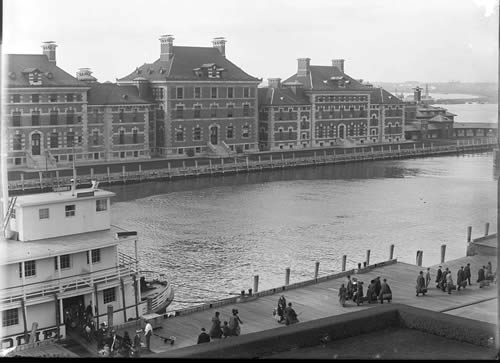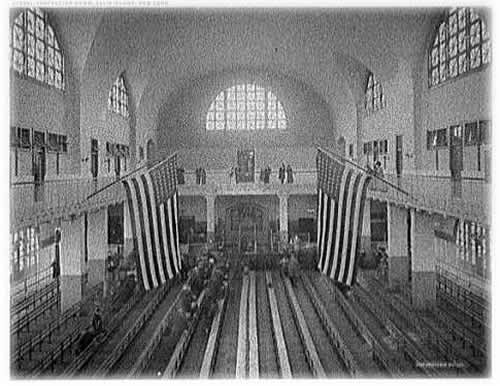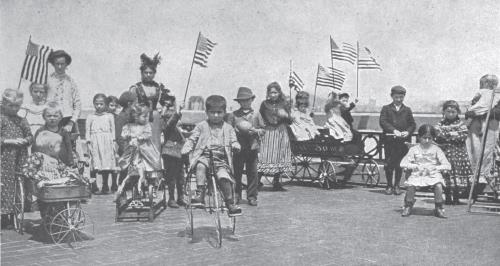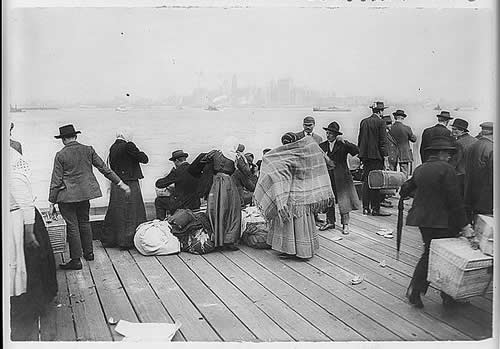Landing at Ellis Island - Processing the Steerage Passenger
IX LANDING AT ELLIS ISLAND
N0 cabin passenger ever sailed through the Narrows and beheld the Statue of Liberty without feeling a thrill at the sight. If it were not the thrill of patriotic
devotion to his native or adopted land, it must be a thrill of pleasure at being safely across and with a chance to set foot on solid ground so soon again. But, if the sight of the goddess stirs the cabin, what must it mean to the steerage ?
To the steerage a new world is dawning and a week or more of an earthly purgatory ending. Dr. Steiner, the eminent immigration authority who has carried his gospel of kindness into many a steerage, himself acknowledges that often he has tried to overcome the deep despair of the steerage by reminding its people that though it seems like hell, there is a heaven beyond.
He says that it is not easy to travel in the steerage; not because there is not room enough, or air enough, or food enough, although that is all true; but because it is hard to believe down there that the God of Israel is not dead.
To the immigrant Ellis Island is an ordeal.

Arrival at Ellis Island (1910)
The " man at the gate " is a big giant who can speed him through or crush the life out of his hopes in an instant. A thousand lies, some useful, some useless, and some unnecessary, are prepared in the hope that they will help in the navigation of the tortuous channel of admission to America. Passing quarantine and the customs officials as the ship comes up the bay, it is warped into its dock, and when the last cabin passenger has gone ashore the steerage people are put into barges and towed away to Ellis Island, where final judgment awaits them.
Their tickets are fastened in their caps, or pinned to their clothes, and their bills of lading are in their hands. When they enter they are lined up in long rows, with two doctors for each row. They must walk down a narrow lane made by rows of piping, with an interval of twenty feet between them.
As they approach, the doctors begin to size up each immigrant. First they survey him as a whole. If the general impression is favorable they cast their eyes at his feet, to see if they are all right. Then come his legs, his body, his hands, his arms, his face, his eyes, and his head. While the immigrant has been walking the twenty feet the doctors have asked and answered in their own minds several hundred questions. If the immigrant reveals any intimation of any disease, if he has any deformity, even down to a crooked finger, the fact is noticed.

Inspection of Immigrants at Ellis Island (1910)
If he is so evidently a healthy person that the examination reveals no reason why he should be held, he is passed on. But if there is the least suspicion in the minds of the doctors that there is anything at all wrong with him, a chalk mark is placed upon the lapel of his coat.
After passing the surgeons who examine their health tickets and their bodies, the immigrants next encounter the one who examines their eyes. With towels and antiseptic solutions by him, the surgeon rolls the eyelids of the immigrants back on a round stick resembling a pencil. He is looking for trachoma. Those discovered to have it are sent away for deportation.
The line moves on past the female inspector looking for prostitutes, and then past the inspectors who ask the twenty-two questions required by law. Here is where the lies are told. Most of the immigrants have been coached as to what answers to give.
Here is an old woman who says she has three sons in America, when she has but one. The more she talks the worse she entangles herself.
Here is a Russian Jewish girl who has runaway to escape persecution. She claims a relative in New York at an address found not to exist; she is straightway in trouble.

Roof Garden For Immigrant Children At Ellis Island
The surgeons mark about half of the immigrants with chalk marks as they file by, and those so marked go to another pen for further examination. Families are torn asunder, and no one has time or opportunity to explain why. Mothers are wild, thinking that their children are lost to them forever; children are frantic, thinking they will see their parents no more. Husbands and wives are separated and for hours they know not why or how.
After the immigrants have passed the inspectors comes the real parting of the ways— the " stairway of separation." Here are three stairways, one leading to the railroad room, another to the New York room, and another to the ferry.
To those who have passed muster in this ordeal the way is now open. They are inside the gate and their troubles are over. But here is a room where those go who have been given tickets marked " S. I.—Special Inquiry." This takes them to an iron barred gate behind which sits an official who admits them and has them distributed to the various detention rooms. Sometimes two thousand may be detained at a time.
Conditions are admittedly bad in some of these rooms, due to overcrowding and inadequate facilities, but all agree that the officials and those under them do all in their power to ameliorate these conditions.
Those detained are given further examinations. Such as are able to pass muster under these examinations are permitted to pass through the gates. Those who are temporarily ill are sent to the hospital. Those who are possibly deportable are given further examinations by special inquiry boards. Those to whom the gates still are barred after these inquiries, have the right of further appeal, but reversals are not very frequent.
Does the law work hardships at our immigration stations ? Yes, everybody admits that.
Sometimes men are turned back for trivial causes. Four Greeks were going to Canada, via New York. The Canadian law requires each immigrant to have twenty-five dollars. They had $24.37 each. When they found their funds short they wanted to come into the United States, but they could not.
A child is taken down with a contagious disease and is carried to the hospital. The mother must wait and cannot even see her child. A man and his son have had their money stolen from them in the steerage; they lack twenty dollars and must go back. And so the sad tale goes on every day.
But could the immigration authorities be vested with discretion in the matter ? Then sixteen thousand debarred aliens a year would lay siege to their sympathies and each would regard his own as a special case, and innumerable difficulties would result. All authorities agree that the system in vogue is just about as humane and as free from hardships as any system that might be devised, and that would maintain the interests of the nation as paramount to the interest of the individual immigrant.
It is, however, equally agreed that Ellis Island is often overcrowded and needs enlargement and that many minor changes in the immigration laws ought to be enacted.
Sixteen thousand immigrants debarred from the United States in a year ! Half of these are debarred because they probably would become public charges. Some 2,300 were deported upon surgeons' certificates showing that they possess mental or physical defects which might affect their ability to earn a living. Another 1,800 were sent back because they had loathsome or dangerous contagious diseases, while 1,333 were denied admission because they were contract labourers.
Ellis Island receives about two-thirds of all the immigrants that come to America. It is really a plant built on three islands with causeways connecting them. Often more than two thousand immigrants must be detained overnight, and of course there is much congestion at such times. To shelter and feed two thousand people over night is a large task. Some days as many as five thousand immigrants arrive, and to dispose of them means only two minutes to each immigrant; consequently, the inspectors must work rapidly and send every doubtful case to detention for further investigation. The next day may bring only a few hundred, or it may be a foggy day and none will come; then the detained ones can be given more attention.
The " old " immigration is usually easy to inspect. Few of them come who are not eligible, for our immigration laws are understood in northwestern Europe much better than in southern and eastern Europe. Five thousand " old " immigrants can be put through easily in a day, while with the " new " immigration such a task would represent very hard work and very long hours.
A contract restaurant is maintained at each important immigrant station, where food can be had during detention, and where it is put up in boxes for those going on railroad journeys. These boxes cost from fifty cents to a dollar.
Special immigrant trains are made up to handle those who travel in large companies. At other times they are furnished special cars, while often they must travel, men and women, in the smokers of regular trains. The immigrant gets a slightly cheaper rate than first class, but they usually get a proportionately poor service for their money.
Ellis Island, with the tragedies of detention and deportation that must be enacted constantly if the laws are to be executed, is a great theatre where every quality of human nature is at play. Here one beholds a happy reunion—wife has come to join husband after waiting for a year until he could get money to send for her. There is another wife to join her husband, but she has trachoma and cannot be admitted.
Here is a painted woman trying to lie herself through the gate. There is a boy who gets tangled up in the forty questions put to him, but finally gets through. Here are hundreds who have failed on their first round to pass muster, and they are gathered in a great room, some hoping and praying, some weeping and fearing, some cursing their fate. But even then, we admitted 838,000 during the fiscal year 1912 and deported only 16,000.

Immigrants Awaiting Transfer - Ellis Island (1912)
Not at any other place in all the history of nations have been enacted so many silent dramas of the human heart as at Ellis Island. It is the door of hope to millions of European peasants who are saving their copper coins against a chance of entering there. It is the gate of new life to millions of adopted Americans who remember that there they were freed of countless terrors that their fathers deemed inescapable. And it has been the seat of doom to tens of thousands who have been turned away from its portals.
Source: The Immigrant: An Asset and A Liability by Frederic J. Haskin, 1913, New York, Chapter 9: Landing at Ellis Island, Pages 74-82. This book is a reproduction of a series of articles which were published in a large list of newspapers throughout the United States. The material was taken largely from the exhaustive reports on immigration made by the federal government. Originally presented as the author's thesis (doctoral -- University of London).
Additional Photographs from the Gjenvick-Gjønvik Archives Immigration Collection
